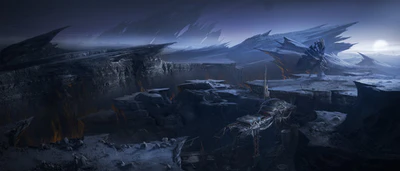"I had put my ship on automatic, bearing for Hades III, and then climbed down to the middeck. As I stepped toward the hold, I caught sight of something in the darkness. I couldn’t say it was even Human, but Humanoid at least. I had an immediate impression of a body with exposed musculature, covered in blue-hued veins. It turned to look right at me when my ship suddenly rocked. It was gone. It was a nanosecond of an encounter, but I was left with a terrible sense of presence. It was as though I’d seen something my mind couldn’t understand. The feeling never passed. I sold the ship when I got home; it didn’t feel like mine anymore.”"
Eli Thorn, Navjumper
Technically classified as unclaimed by UEE stellar cartography, Hades was once home to an impressive civilization that seems to have destroyed themselves. With a F-type main-sequence star at its center and several surviving planets in orbit, the system lacks the conditions necessary to support Human life.
Hades was first identified in 2515] by the Merry Crow, a tramp freighter. The discovery was not formally cataloged because the ship was carrying several hundred freight units of stolen fusion drives. Nineteen years later, Jake Tapps, the Crow’s navigator and sole surviving crew member, found himself penniless and planetbound. He sold the ship’s extensive logbooks to finance a longtime SLAM habit and the Hades System was officially registered by the Dynamo Corporation.
Interest in the system skyrocketed once exploration ships conducted their initial survey. While the system was deemed totally inappropriate for terraforming, they located significant evidence that all of the worlds were once home to an extinct spacefaring society. Decades of research have been unable to create a complete picture of an advanced society that ultimately wiped itself out through internecine conflict. It was this grandiose level of destruction that gave the system its name and made unlocking the truth seemingly impossible.
While there are no facilities for refueling or ship maintenance in the Hades System, it is still part of an active spacelane. However, most ships stick to the shipping lanes between jump points. For most, only danger awaits those who venture off course.
Most of those who are willing to traverse onto the planets are xenoarchaeologists and tomb raiders. Despite the widespread devastation, thousands of shattered structures have been identified on Hades’ graveyard worlds, and many more are believed to exist underground. Countless artifacts are taken (or stolen) from these sites each year, and it is believed that there are a number of ongoing operations from questionable corporations trying to locate some of the technology that the Hadesians used to destroy themselves.
The first planet in the system completely lacks any atmosphere. Scattered unnatural craters and ruins indicate that the Hadesians must have colonized Hades I in a limited capacity. Scientists have been unable to figure out whether it was always this way or whether the atmosphere was another victim of the war.
Hades II retains something of an atmosphere, but it is a violent one. Environmental suits must be worn, and due to the amount of volcanic ash in what remains of the atmosphere, no one should ever be away from a breather. Sprawling Hadesian cities spider across the landscape, every single one of them dead and withering away in the unrelenting wind. The unstable nature of the ruins makes this surface a very precarious one to try and explore.
Deposits of unusual minerals including kherium have been discovered amidst the rubble on Hades II. Although, due to the archaeological value of the system, no major mining operations have ever occurred. Thanks, in large part, to a diligent group of activist archaeologist and preservation groups that keep a vigilant eye on the planet’s topography, and threaten to publicly shame any mining operation that disturbs it.
On the surface, Hades III matches I and II: it is a gruesome landscape of impact craters and shattered cities. The atmosphere is toxic, and only the best-equipped teams should attempt to make landfall. Despite this, countless ruins have been documented over the years, perpetuating the belief in certain circles that there is still much to discover in Hades.
Hades IV is commonly considered a ‘half planet,’ leading to the somewhat confusing ‘3.5 worlds’ listing in the formal UEE listing. While the entire planet still exists (and has not degenerated into a complete asteroid field) it does so in two distinct halves. It’s impossible to wholly comprehend the absolute horror of a weapon capable of destroying an entire planet, but it is difficult not to marvel at the spectacle of this desolation.
The Hadesians
There are as many theories about the Hadesians’ nature as there are stars in the sky. Every year, a fresh batch of university graduates descends on the system, hoping that they will be the ones to finally crack the mystery of this civilization, and every year, they go away in frustration. Scientists have managed to roughly determine their physical dimensions and that their civil war was fought roughly 300,000 years ago. Based on sparse skeletal and architectural evidence, a recent theory that Hadesians were roundish creatures with a bulky central body with multiple thin appendages (a number that apparently varies from Hadesian to Hadesian) and a pair of long arms complete the figure. A sharp contrast to what was considered the most accurate renderings of Hadesians from researchers only a few years prior.
